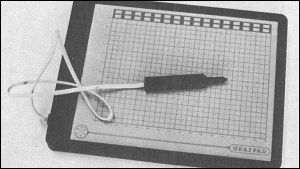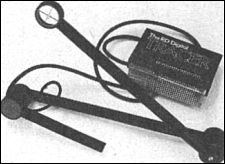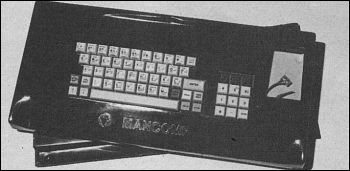| Hardware World |
IF YOU have spent many hours trying to draw pictures on the Spectrum the Grafpad from British Micro is a godsend. It is possibly the easiest way to design a masterpiece and something the dedicated artist should not be without. The only major drawback is the price, £125 plus VAT.

A graphics pad, or digitising tablet as they are sometimes called, is simply a pad which represents the TV screen. A pen, electrical not ink, is used to draw on its surface and that is reproduced on screen.
It connects to the Spectrum user port by way of a 18cm flexible cable, which excludes the use of any other add-ons other than those with a through port, such as Interface 1. The cable connects to the right hand side of the pad and so it can only be sited to the right of the computer. That is a problem for left-handed people or those with a full size keyboard where the Spectrum PCB tends to be on the left. The cable can not be extended without causing the system to lock.
The pen also plugs into the right hand side, using one of the increasingly popular telephone style jacks, and the software to run the system is supplied on cassette.
To help you draw you can set a window which will limit the area of screen on which you can work, ensuring you do not disturb the rest of the drawing.
Areas of the screen can be magnified for clarity and then reduced and there are two overlay grids, one which simply strips all the colour to show ink and paper and the other which highlights the character squares using Bright.
Once the picture is on screen the whole thing can be inverted, ink to paper, or flipped, left to right and up and down. It can be scrolled in four directions and will wrap around.
If you can afford it then contact British Micro, Hertfordshire.
FULLER is dead, long live Fuller. From the ashes of Fuller's demise Nordic Keyboards UK has risen like a phoenix to carry on the name.
Nordic Keyboards, who used to make the keyboards for Fuller, stepped in, bought up the old stock, and is now selling all the old products, including a brand new keyboard.
The Executive keyboard is outwardly very similar to the Fuller FDS, but inside it has been completely changed. You no longer have to remove the Spectrum from its case.
Interface 1 users are also catered for and with a little minor surgery to the back of the case it too can be fitted inside.
The keyboard gives you nine extra function keys, as well as doubling up the shift keys. These are four shifted cursor keys, E mode, Delete, Full Stop, Comma and shifted Break. The only other key which might have been useful would have been Edit but the two oversize Caps Shift keys almost make up for it.
As with the original Fuller keyboards it rattles a little in operation but the keys have a good, if light, feel to them. The shifted cursor keys are a boon when programming or word processing.
The price of £59.95 puts it in the middle of the keyboard price range among many which do not have moving keys, which require you to disassemble the Spectrum and which do not have as many functions.
Further details of Fuller products including a revamped FDS, can be obtained from Nordic Keyboards UK, Merseyside.
HAVE YOU ever wished that there was some way to slow a game so you could get past the first screen without getting zapped? If so your wish has been granted by Cambridge Computing with its new Slomo device.
On the front of it are two push buttons, a rotary speed control and an LED.
One of the buttons is used to stop the Spectrum and the other activates the speed control.
Slomo lends itself to a number of uses. For the games player it allows that extra edge while the machine code addict can use it to see, if it is on screen, the code working step by step. Listings can be slowed and anything normally too fast can be set to a manageable speed.
An ingenious device and reasonably priced at £14.95, from Cambridge Computing, Cambridge.

TWO YEARS ago RD Laboratories launched the RD Digital Tracer for the Spectrum. RD has now brought out a new version which can work on areas up to A3 in size.
As well as reproducing lines you can draw shapes, fill areas, change colours and insert text. You can store a sequence of movements and then replay it.
Microdrive users are catered for with a program which can be merged into the main program.
The tracer connects to the Spectrum user port by way of a ZX-81 size connector. It has a through connector for other add-ons but, other than the ZX Printer, there are few which do not require all the lines. The new version does not differ greatly from the old. It is accurate and moderately easy to use but it is extremely slow.
At a price of £75.50, including VAT, the Tracer could be better. It may have been marvellous two years ago but the add-on buyer is older and wiser now.
The Tracer is sold by Kane-May Ltd, Hertfordshire.
MANCOMP is the latest company to enter the highly competitive add-on keyboard market for the Spectrum. Its M0184 keyboard is attractively styled but unfortunately, its looks are deceptive.

The casing is large, and has a cut-out for the power supply, and an indent at the top to hold a pen. The black top half is constructed from glass fibre; that makes cutting it or screwing the base to it difficult unless you have muscles like Arnold Schwarzenegger.
The green base is made of an indeterminable material, rather brittle around the screw holes. To fit a Spectrum the top half of its case is removed and the bottom half fitted to the base. It is held by two plastic tabs at the front - barely adequate, especially if an Interface 1 is fitted. There is nothing between the Spectrum PCB and the keyboard PCB, a potentially dangerous state of affairs . When fitting Interface 1 a slot for the microdrive lead will have to be cut in the casing.
The keyboard has the usual forty keys, although the bottom row is not offset as in the standard QWERTY layout, plus extra ones. On the right is a numeric pad with an extra Enter and single function Full Stop. The main pad has two extra Caps Shifts, in yellow, and one extra Symbol Shift, in red. There is also a Break key and four cursor keys, in green, placed either side of the full size space bar, which all require shifting. The legends are stuck on but are due to be replaced with directly printed ones.
You will either like the feel of the keys or not. The tops occasionally foul the switches, depending on where you press them.
Provided you are prepared to spend some time working on it the keyboard could be made reasonable, but it costs £54.95 and there are many others within the same price range with much more going for them. For further information contact Mancomp Ltd, Manchester.
THE PROTEK 1200 modem and Spectrum interface are now available and can operate in two modes, 1200/75 for database connection such as Prestel and Micronet 800 and 1200/1200 for user-to-user communication over the telephone lines.
In Prestel mode the Spectrum becomes a Prestel keypad and basic information on using it in that mode is given in the instructions.
In user-to-user mode the other party you are contacting must also have a Protek 1200 modem running under the same software. After setting up the telephone link, informing the system of where the file you want to send sits in memory and defining block start and size for the code you are ready to transfer data.
Priced at £59.95 for the modem and £24.95 for the Spectrum interface they are available from Protek Computing.
SERIOUS users of the Spectrum have long bemoaned the lack of a way to drive a monitor. Adapt Electronics has now brought out a RGB interface which should drive all standard monitors which can accept TTL input.
As usual, it connects to the Spectrum user port and is dead-ended. It connects to the monitor by a 6 pin DIN socket.
Compared to the normal TV output the picture is rock steady and very clear. The only drawback is that Bright will not work.
The interface, priced £29.95 plus £1 p&p, is available from Adapt Electronics, Essex.
ONE of the problems with the Spectrum is that the Z80 CPU can only address 64K of memory. With 16K taken up with the ROM that only leaves 48K to play with.
The XK upgrade from Television Services of Cambridge goes a long way to solving the problem. Available as a kit, or fitted by the factory, it allows you to page the upper 32K of memory and, when fitted to a standard 48K Spectrum, gives you access to the unused side of the internal memory. The amount of extra memory gained in this way will vary from perhaps a few bytes to, if you are lucky, the full 32K.
In addition up to 128 pages can be added externally. More than two or three will need an extra power supply, which makes a 4Mb Spectrum a reality. As the system only uses A1 to page the memory it will clash with any Sinclair hardware such as Interface One, and, with a few exceptions, be transparent to software.
Fitting the kit is not for the nervous as not only do you have to solder direct to the Spectrum PCB but you also have to cut a number of tracks. That will play hell with your warranty.
The system can be used on its own but it is supplied with a Basic extension that gives you windows and multi-tasking. Each page can be assigned a window, only limited by the number of pages, and each can have a program running in it at the same time. The lower 16K can be used to pass information from one page to another.
The way the commands are used will depend on whether you have Interface 1 fitted. If so they take the form of, for example, *pagen or *multi. which swops pages or calls the multi-tasking. Without Interface 1 RAND USR statements have to be used.
Although the system should not be affected by commercial software some, notably the Ultimate programs Sabre Wulf and Atic Atac, cause it to crash. A loader program will soon be made available to overcome that.
For £15.95 for the kit, or £20.95 fitted, both inclusive of VAT and p&p, the system has a lot to offer. Provided more software is made available it could tempt users away from spending £400 on a QL. For more information contact Television Services of Cambridge Ltd.